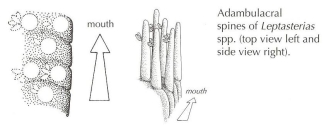Members of the Leptasterias hexactis complex have six arms 4 to 8 cm long, each with a distinct carinal row whose plates bear one to three spines apiece. This group of sea stars has arm-to-disc ratios ranging from 3.3 to 5.4. It generally appears to have short stubby arms with an obvious row of light coloured spines down the centre of the arm and widely spaced capitate, dorsolateral spines irregularly arranged in a loose reticulate pattern. The superomarginals have one or two spines, rarely three, and the inferomarginals two. The oral intermediates are usually in a single well-developed series extending beyond half the arm, but never two rows. The adambulacrals have one or two spines, with clusters of crossed pedicellariae on their distal sides.
Characteristics
Similar SpeciesSmall Leptasterias may be confused with juveniles of Pisaster ochraceus or Evasterias troschelii, which occasionally have six arms. P. ochraceus has a single spine on each adambulacral, with a cluster of pedicellariae at the base but not on the spine. Leptasterias has one or two spines per plate with a cluster of pedicellariae on the spine itself. E. troschelii has pedicellariae on the adambulacrals but an arm-to-disc ratio of 5.0-7.6 and six similar rows of spines between the superomarginals and the furrow, made up of two inferomarginals and four oral intermediates. Leptasterias has no more than two oral intermediates.
